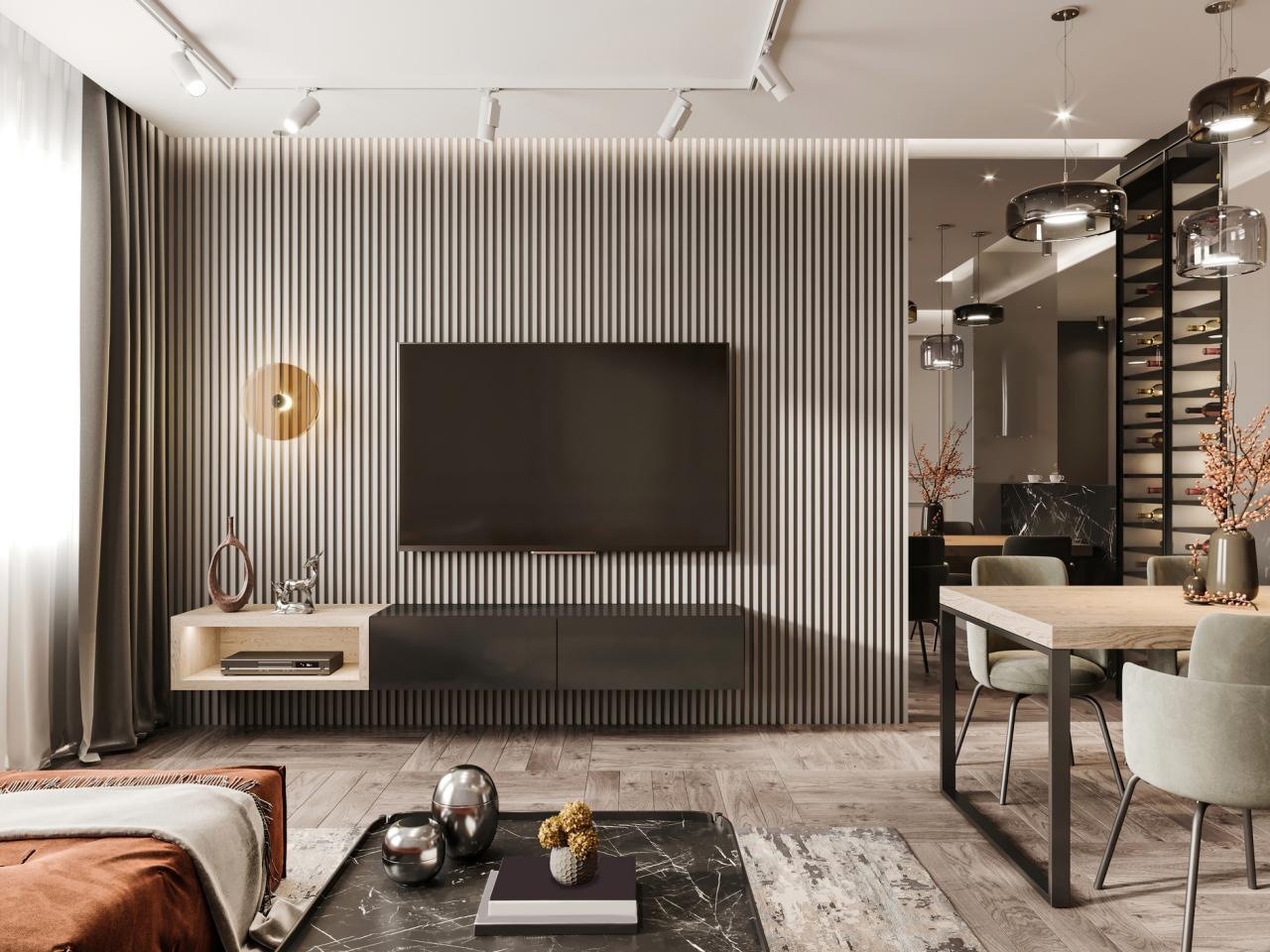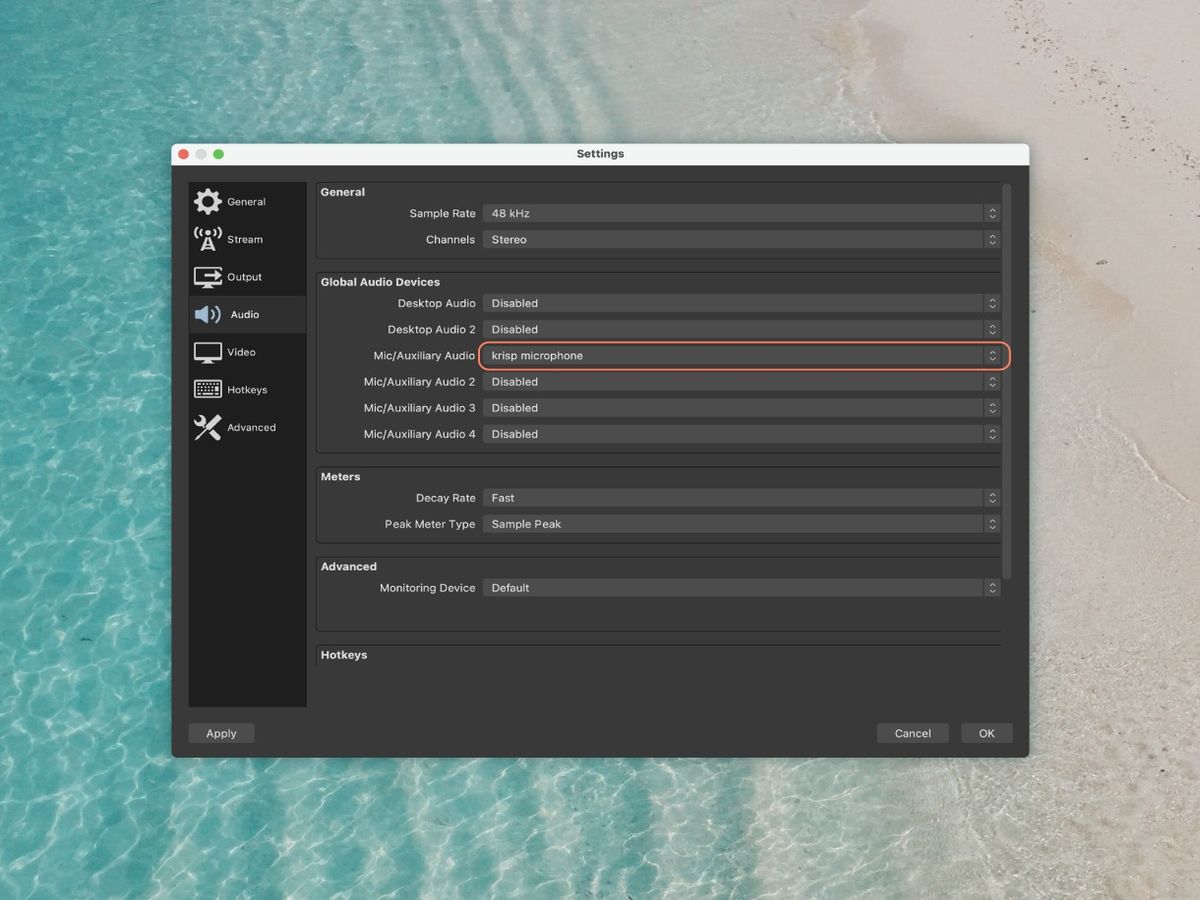Home>Production & Technology>Noise Cancellation>How To Add Noise Cancellation To A Room


Noise Cancellation
How To Add Noise Cancellation To A Room
Modified: January 26, 2024
Learn how to easily add noise cancellation to any room with our step-by-step guide. Transform your space into a peaceful oasis and enjoy uninterrupted moments.
(Many of the links in this article redirect to a specific reviewed product. Your purchase of these products through affiliate links helps to generate commission for AudioLover.com, at no extra cost. Learn more)
Table of Contents
- Introduction
- Importance of Noise Cancellation
- Assessing the Room’s Acoustic Environment
- Identifying Noise Sources
- Strategies for Soundproofing
- Applying Acoustic Panels
- Using Soundproof Curtains
- Installing Weatherstripping and Door Sweeps
- Adding Mass Loaded Vinyl
- Sealing Air Leaks
- Incorporating White Noise Machines
- Conclusion
Introduction
Welcome to the ultimate guide on how to add noise cancellation to a room. In today’s noisy world, finding a peaceful and quiet space can be a challenge. Whether you’re working from home, studying, or just seeking a relaxing atmosphere, noise pollution can be a major distraction. Fortunately, with advances in technology and soundproofing techniques, it’s now possible to create a serene environment even in the midst of a bustling city or a loud neighborhood.
Noise cancellation refers to the process of reducing or eliminating unwanted sounds to create a more favorable acoustic environment. It involves implementing various strategies and utilizing specialized materials to block or absorb noise, allowing you to enjoy a quieter and more tranquil space. Whether you want to convert a spare room into a home office, create a peaceful bedroom, or simply reduce external noise from seeping into your living area, noise cancellation techniques can make a significant difference in the quality of your space.
In this comprehensive guide, we will explore the various aspects of noise cancellation and provide practical solutions to help you transform any room into a haven of tranquility. From assessing the current acoustic environment to identifying and addressing specific noise sources, we will walk you through the steps necessary to achieve optimal noise cancellation. We will delve into different strategies, such as soundproofing, using acoustic panels, implementing soundproof curtains, and more. By the end of this guide, you will have a clear understanding of how to effectively add noise cancellation to your desired room.
So, whether you’re struggling with noisy neighbors, traffic sounds, or any other intrusive noise, get ready to reclaim your peace and quiet. Let’s dive in and discover the secrets to creating a noise-free environment.
Importance of Noise Cancellation
Noise cancellation is not just about creating a quiet space; it is about creating an environment that promotes productivity, relaxation, and overall well-being. Excessive noise can have detrimental effects on our mental and physical health, making it essential to prioritize noise cancellation in our daily lives.
One of the key benefits of noise cancellation is improved focus and concentration. Whether you’re studying, working, or engaging in creative activities, a quiet environment can enhance your ability to concentrate on the task at hand. By reducing or eliminating background noise, noise cancellation allows you to fully immerse yourself in your work or study, leading to increased productivity and efficiency.
Noise cancellation is also crucial for creating a peaceful and restful atmosphere. When it comes to relaxation and sleep, unwanted noise can be incredibly disruptive. By implementing noise cancellation techniques, you can minimize the impact of external sounds, such as traffic noise, loud neighbors, or barking dogs, and create a calm and serene environment for rest and rejuvenation.
Furthermore, noise cancellation can have a significant impact on our stress levels and overall well-being. Excessive noise has been linked to increased stress, anxiety, and even negative impacts on cardiovascular health. By reducing the noise around you, you can create a more peaceful and calming space, promoting relaxation and reducing the negative effects of stress on your body and mind.
Noise cancellation is not only beneficial for your personal well-being but also for your relationships and social interactions. Noisy environments can make it difficult to have conversations, leading to misunderstandings and frustration. By implementing noise cancellation techniques, you can create a space where communication is clear and effortless, improving your relationships and overall social experience.
Finally, noise cancellation can enhance the overall quality of your living or working environment. Unwanted noise can be a constant source of annoyance and discomfort, diminishing your satisfaction and enjoyment of a space. By investing in noise cancellation solutions, you can transform your room into a haven of peace, comfort, and enjoyment, allowing you to fully appreciate and make the most of your surroundings.
Overall, noise cancellation is not just a luxury; it is a necessity in today’s noisy world. By prioritizing and implementing noise cancellation techniques, you can create a quieter, more serene, and harmonious environment that positively impacts your productivity, relaxation, and overall well-being.
Assessing the Room’s Acoustic Environment
Before diving into noise cancellation techniques, it is crucial to assess the acoustic environment of the room you wish to improve. Understanding the existing noise levels and characteristics will help you determine the most effective strategies to achieve optimal noise cancellation.
Start by identifying the sources of noise that affect the room. Is it mainly external noise, such as traffic or construction? Or is it noise coming from within the building, like appliances or loud neighbors? By pinpointing the primary sources of noise, you can focus your efforts on addressing them specifically.
Next, consider the dimensions and layout of the room. Large, open spaces with hard surfaces tend to have more reverberation, causing sounds to bounce around and create a noisy environment. On the other hand, smaller rooms with carpeting or soft furnishings may absorb more sound, resulting in a quieter atmosphere. Understanding these factors will guide you in selecting the appropriate noise cancellation techniques for your specific room.
Take note of any existing materials or structures that may contribute to noise transmission or amplification. For example, thin walls, single-pane windows, or hollow doors can allow sound to easily pass through, compromising the room’s soundproofing. Identifying these weak spots will help you prioritize them when implementing noise cancellation measures.
Lastly, consider the nature of the activities that take place in the room. Different activities require varying levels of noise cancellation. For instance, a home office may require more focused noise reduction compared to a living room or bedroom. Tailor your noise cancellation efforts to suit the specific needs and purposes of the room.
By thoroughly assessing the room’s acoustic environment, you gain valuable insights into the specific challenges and opportunities for noise cancellation. This information will serve as the foundation for the subsequent strategies and techniques you will use to create a quieter and more comfortable space.
Identifying Noise Sources
To effectively implement noise cancellation techniques, it is essential to identify the specific noise sources in the room. By pinpointing the culprits behind the unwanted noise, you can address them directly and significantly improve the overall soundproofing of the space.
Start by listening carefully to the environment and taking note of any persistent or disruptive sounds. Isolate each noise source and try to determine its origin. Common noise sources include traffic noise, neighboring rooms or apartments, HVAC systems, appliances, and even ambient sounds like birds or wind. By identifying these sources, you can develop targeted strategies to mitigate their impact.
If the noise primarily comes from outside, such as traffic or construction, consider the building’s exterior. Check for any gaps or cracks in windows, doors, or walls that may allow sound to enter. Additionally, assess the effectiveness of existing windows in blocking out noise. Upgrading to double-pane windows or adding soundproofing films can make a significant difference in reducing external noise infiltration.
If the noise is generated within the room or building, focus on identifying the primary culprits. Are there specific appliances or machinery that generate excessive noise? Consider relocating them to a separate area or installing soundproof enclosures to isolate their noise. If you are dealing with neighbors’ noise, such as footsteps or loud voices, examine the walls for potential weak spots and address them with soundproofing materials.
Once you have identified the noise sources, consider their dominant frequencies. Different materials and techniques are more effective at reducing certain frequency ranges. For example, low-frequency sounds may require mass-loaded vinyl or additional layers of drywall, while high-frequency sounds can be mitigated with acoustic panels or foam absorbers.
It’s important to note that noise sources can sometimes be complex, with multiple contributing factors. Consider consulting a professional acoustic engineer or noise specialist who can provide expert advice on identifying and addressing the specific noise sources in your room.
By properly identifying the noise sources, you can design a targeted plan to effectively reduce or eliminate them. Understanding the origin, frequency, and characteristics of the noise will enable you to select the most appropriate noise cancellation techniques and materials for optimal results.
Strategies for Soundproofing
When it comes to soundproofing a room, there are several strategies and techniques you can employ to effectively reduce noise transmission and enhance overall noise cancellation. By combining these strategies, you can create a more peaceful and quiet environment. Let’s explore some of the most effective soundproofing methods:
- Seal air leaks: Air gaps and leaks in windows, doors, and walls can allow sound to easily travel through. Use weatherstripping and door sweeps to seal any gaps and prevent noise infiltration.
- Insulate walls and ceilings: Adding insulation materials, such as fiberglass or mineral wool, within walls and ceiling cavities can significantly reduce noise transmission. This is especially effective for blocking airborne sounds.
- Install soundproof curtains: Heavy, dense curtains with sound-dampening properties can provide an additional layer of sound insulation. They can absorb both airborne and reflected sound, reducing noise levels in the room.
- Use acoustic panels: Acoustic panels are designed to absorb sound waves, minimizing echoes and reverberations. They can be strategically placed on walls or ceilings to improve the overall acoustics of the room.
- Add mass loaded vinyl: Mass loaded vinyl (MLV) is a dense and flexible material that blocks sound transmission. Install MLV on walls, floors, or ceilings to reduce noise infiltration from adjacent spaces.
- Upgrade windows and doors: Double-pane windows with a layer of air or gas in between provide better insulation against external noise. Solid core doors or adding door sweeps can also help in minimizing sound transmission.
- Apply carpeting or rugs: Thick, plush carpeting or area rugs can absorb sound and reduce impact noise, particularly in rooms with hard flooring surfaces.
- Consider decoupling: Decoupling involves creating a gap between surfaces to stop sound vibrations from transmitting. This can be achieved by installing resilient channels or isolating walls and ceilings with soundproof clips and channels.
- Utilize white noise machines: White noise machines emit a constant, soothing sound that helps to mask and drown out other ambient noises, creating a more peaceful environment.
It’s important to note that the effectiveness of these soundproofing strategies will depend on various factors, such as the type of noise, the construction of the room, and the desired level of noise cancellation. Experimenting with a combination of these techniques can help you find the optimal soundproofing solution for your specific needs.
By implementing these soundproofing strategies, you can significantly reduce noise transmission and create a quieter, more comfortable space. Remember to assess the specific requirements and characteristics of your room to ensure the most effective and appropriate soundproofing methods are employed.
Applying Acoustic Panels
Acoustic panels are a popular and effective solution for improving the sound quality and reducing noise in a room. These panels are designed to absorb sound waves, minimizing echoes, reverberations, and overall noise levels. Here’s a guide on how to apply acoustic panels for optimal noise cancellation:
1. Identify key reflection points: Start by determining the primary areas where sound reflections are occurring. These are typically the walls and ceiling directly facing the main sound source. Reflection points can be identified by standing in different areas of the room and listening for where the sound is the loudest and most reflective.
2. Measure and mark the panel placement: Measure the dimensions of the reflection points and mark the placement of the acoustic panels. Ensure that the panels cover a significant portion of the reflection areas to maximize sound absorption. Consider spacing the panels evenly for even distribution of sound absorption throughout the room.
3. Prepare the wall surface: Clean the wall surface where the panels will be mounted. Remove any dirt, dust, or debris that may affect the adhesive properties of the panel. If the wall is uneven or textured, consider applying a layer of smooth wallpaper or a panel adhesive board to create a flat surface for optimal panel adhesion.
4. Apply the adhesive: Depending on the type of acoustic panels you have, apply the recommended adhesive to the back of each panel. Follow the manufacturer’s instructions for proper application. Double-check the adhesive curing time to ensure a strong and secure bond between the panels and the wall surface.
5. Mount the panels: Carefully place the panels on the marked areas of the wall, pressing firmly to ensure proper adhesion. Use a level to ensure the panels are straight and aligned. If using multiple panels, continue the process until all panels are securely mounted on the wall.
6. Consider panel arrangements: Experiment with different arrangements and orientations of the panels to optimize their performance. Vertical or horizontal arrangements, as well as staggering the panels, can provide varying levels of sound absorption. Adjust the placement as needed to achieve the desired soundproofing effect.
7. Create a decorative finish: Acoustic panels come in various colors, patterns, and textures, allowing you to incorporate them seamlessly into your room’s aesthetics. Consider coordinating the panel design with your existing décor to create a visually appealing and harmonious space.
8. Assess and adjust: After applying the acoustic panels, take the time to assess the impact on the room’s acoustics. Listen for changes in sound quality, reduction in echoes, and overall noise reduction. If necessary, make adjustments to the panel placement or consider adding more panels in areas that require additional sound absorption.
Applying acoustic panels is a relatively simple and effective way to improve the acoustics and reduce noise in a room. By strategically placing these panels in key reflection points, you can achieve optimal noise cancellation and create a more pleasant and comfortable environment.
Using Soundproof Curtains
Soundproof curtains are a versatile and practical solution for reducing noise in a room. These curtains are specially designed to block and absorb sound waves, minimizing noise transmission from both external and internal sources. Here’s how you can effectively use soundproof curtains to enhance noise cancellation:
1. Select the right soundproof curtains: Look for curtains specifically designed for soundproofing, as they are made with dense and heavy materials that have sound-dampening properties. Consider curtains with multiple layers and a thick lining to provide maximum noise reduction.
2. Measure the window or door: Take accurate measurements of the window or door where you plan to hang the soundproof curtains. Ensure the curtains are wider and longer than the window or door frame to completely cover the opening and create a seal for optimal noise blocking.
3. Install curtain rods or tracks: Depending on the weight of the soundproof curtains, choose an appropriate curtain rod or track that can support the curtain’s heaviness. Install the rod or track securely, ensuring it is level and properly anchored.
4. Hang the soundproof curtains: Attach the soundproof curtains to the curtain rod or track, making sure they are evenly spread and reach all the way to the floor. Consider using curtain hooks or rings for smooth and easy movement of the curtains.
5. Create an overlap: If you have multiple soundproof curtains, consider overlapping them in the center to minimize any gaps where sound may seep through. This overlapping technique further enhances the soundproofing capabilities of the curtains.
6. Seal the edges: To maximize noise reduction, seal any gaps or openings around the edges of the curtains. Use adhesive-backed weatherstripping or foam tape to create a tight seal between the curtain and the wall, floor, or window frame.
7. Consider additional layers: In extremely noisy environments, you can enhance the soundproofing effect by layering the soundproof curtains with regular curtains or blackout blinds. This combination provides an extra barrier for noise reduction while maintaining versatility in controlling light levels.
8. Assess the noise reduction: After hanging the soundproof curtains, take the time to evaluate the impact on noise reduction in the room. Listen for a decrease in external noise and an improvement in sound quality. Adjust the curtain placement or consider adding more curtains if needed to further enhance the soundproofing effect.
Using soundproof curtains is an effective and affordable way to reduce noise and create a more peaceful environment. By carefully selecting the curtains, properly hanging them, and ensuring a tight seal, you can significantly enhance the noise cancellation capabilities of your room.
Installing Weatherstripping and Door Sweeps
The gaps around doors and windows are common entry points for noise to infiltrate a room. Fortunately, by installing weatherstripping and door sweeps, you can effectively minimize noise transmission and improve the overall soundproofing. Here’s a step-by-step guide on how to install weatherstripping and door sweeps:
1. Assess the gaps: Begin by inspecting the gaps between the door or window and the frame. Identify any areas where sound may be able to pass through. These gaps can be found along the sides, top, and bottom of the door or window. Pay close attention to any significant openings that may allow noise to enter.
2. Measure and cut the weatherstripping: Using a tape measure, carefully measure the length of the gaps you identified. Cut the weatherstripping material to fit each gap, ensuring a snug and secure fit. For best results, choose weatherstripping made from materials specifically designed for soundproofing, such as rubber, foam, or silicone.
3. Clean the surfaces: Thoroughly clean the areas where the weatherstripping will be applied. Remove any dirt, dust, or residue that may hinder proper adhesion. Use a mild detergent and warm water, and allow the surfaces to dry completely before proceeding.
4. Apply the weatherstripping: Peel off the adhesive backing from the weatherstripping and carefully press it into place along the gaps. Start from one end and gradually work your way to the other, ensuring a smooth and even application. Firmly press the weatherstripping to ensure a strong bond with the door or window frame.
5. Install door sweeps: Door sweeps provide an additional barrier against noise infiltration, particularly along the bottom of the door. Measure the width of the door and cut the door sweep to size if necessary. Position the sweep along the bottom of the door and mark the screw hole locations. Install the sweep using the provided screws, making sure it fits tightly against the floor.
6. Test for proper sealing: Close the door or window and check for any remaining gaps or openings. Run your hand along the edges to feel for any air leaks. Adjust or reapply weatherstripping if necessary to ensure a tight seal. For door sweeps, ensure they are properly aligned, allowing the door to close smoothly while creating an effective barrier against noise.
7. Assess the noise reduction: After installing weatherstripping and door sweeps, take note of how much noise reduction has been achieved. Listen for a decrease in external noise and a more peaceful atmosphere in the room. Depending on the level of noise and the effectiveness of the initial installation, consider adjusting or adding additional weatherstripping if needed.
By installing weatherstripping and door sweeps, you can significantly improve the soundproofing of your room by sealing off gaps and preventing noise from entering. With proper installation and attention to detail, you can create a quieter and more peaceful environment.
Adding Mass Loaded Vinyl
One of the most effective soundproofing materials available is Mass Loaded Vinyl (MLV). MLV is a dense and flexible barrier that blocks sound transmission, making it an excellent choice for reducing noise in a room. Here’s how you can add MLV to enhance noise cancellation:
1. Measure and cut the MLV: Start by measuring the area you want to soundproof with MLV, whether it’s a wall, ceiling, or floor. Use a utility knife or scissors to cut the MLV into the desired size and shape. Make sure to leave a small allowance for overlapping and sealing.
2. Prepare the surface: Clean the surface where the MLV will be applied. Remove any dirt, dust, or debris that may affect adhesion. Ensure the surface is dry and smooth, as any irregularities can compromise the effectiveness of the MLV barrier.
3. Apply adhesive (optional): Depending on the type of MLV you have, you may need to apply adhesive to the back of the vinyl before installation. Follow the manufacturer’s instructions for the recommended adhesive and application method. Be sure to use an adhesive that is specifically designed for MLV installation.
4. Install the MLV: Carefully place the MLV onto the prepared surface. Start from one end and gradually press the vinyl firmly against the surface. Smooth out any wrinkles or air bubbles as you go. For larger areas, consider working in sections to ensure proper alignment and adhesion.
5. Overlap and seal the edges: To ensure maximum noise reduction, overlap the edges of the MLV sheets by a few inches. This prevents sound from finding paths through gaps. Use adhesive or tape to secure the overlapping edges. Ensure a tight seal to prevent noise leakage.
6. Trim and finish: Trim any excess MLV around edges, corners, or fixtures using a utility knife or scissors. Smooth down the trimmed edges to ensure they are flush against the surface. Consider adding a layer of drywall or another finishing material over the MLV for a visually appealing and integrated look.
7. Assess the noise reduction: Once the MLV is installed, take the time to evaluate the impact on noise reduction in the room. Listen for a decrease in external noise and an improvement in sound quality. Consider adding additional layers of MLV or combining it with other soundproofing materials for enhanced noise cancellation, if needed.
Adding Mass Loaded Vinyl is an effective method for reducing noise transmission and improving the soundproofing of a room. With proper installation and sealing, MLV can create a significant barrier against unwanted noise, allowing you to enjoy a quieter and more peaceful environment.
Sealing Air Leaks
One of the key factors in effectively soundproofing a room is sealing air leaks. Air leaks not only compromise the energy efficiency of a space but also allow noise to enter or escape, diminishing the effectiveness of other soundproofing measures. By identifying and sealing air leaks, you can significantly improve noise cancellation. Here’s how to go about it:
1. Identify potential air leak sources: Start by inspecting the room for any areas where air and noise may be able to penetrate. Common air leak sources include windows, doors, electrical outlets, baseboards, and gaps around pipes or vents. Pay attention to both the interior and exterior walls.
2. Check for drafts: On a windy day, close all windows and doors and hold a lit candle near potential air leak sources. Watch for any flickering of the flame, as this indicates air movement. Alternatively, use a smoke pen or an incense stick to detect drafts and airflow.
3. Seal gaps around windows and doors: Apply weatherstripping or caulk to seal any gaps around windows and doors. Use weatherstripping tape or adhesive-backed foam strips to seal the gaps, ensuring a tight seal to prevent both air and noise infiltration. For doors, consider installing door sweeps to seal the bottom gap.
4. Seal electrical outlets and switches: Turn off the power and remove outlet and switch covers. Apply foam gaskets or caulk around the electrical boxes to seal them. Use a caulk gun to fill any gaps between the boxes and the wall. Reinstall the covers once the sealant has dried.
5. Seal baseboards and trim: Inspect the baseboards and trim for any gaps or cracks. Apply caulk along the seams where the baseboards meet the wall and floor. Consider using foam backer rods to fill larger gaps before applying caulk for better insulation and a more secure seal.
6. Seal gaps around pipes and vents: Apply caulk or foam sealant around gaps where pipes or vents enter the room. Ensure a tight seal to prevent air and noise from seeping through. Consider using specialized foam gaskets or collars for better insulation around pipe penetrations.
7. Assess and recheck: Once you have sealed the identified air leak sources, recheck for any remaining gaps or leaks. Run your hand along windows, doors, electrical outlets, and other sealed areas to feel for any remaining drafts. Make adjustments and reapply sealant as necessary.
By sealing air leaks, you not only enhance the soundproofing capabilities of a room but also improve energy efficiency and overall comfort. Take the time to identify and address these leaks, ensuring a tight seal to prevent both air and noise infiltration. With proper sealing, you can significantly enhance the noise cancellation in your space.
Incorporating White Noise Machines
White noise machines are a popular and effective tool for creating a more serene and peaceful environment. These machines emit a constant, soothing sound that helps to mask and drown out other ambient noises, making them an excellent addition to any noise cancellation strategy. Here’s how you can incorporate white noise machines to enhance tranquility in your room:
1. Select the right white noise machine: Choose a white noise machine that suits your needs and preferences. There are various options available, ranging from portable devices to large units that can cover a larger space. Consider features such as different sound options, adjustable volume, and timers.
2. Determine the placement: Decide where to position the white noise machine in the room. Ideally, it should be placed near the area where noise disruptions are most likely to occur. Common locations include near windows, doors, or areas where external noise sources are prominent.
3. Set the desired sound and volume: Select the white noise sound that is most soothing and relaxing to you. Experiment with different options, such as waterfall, fan, or static noises, until you find the one that helps mask the unwanted sounds effectively. Adjust the volume to a level that is comfortable and effectively masks the background noise.
4. Consider the timing: Some white noise machines come with built-in timers that allow you to set specific durations of operation. Consider using the timer feature to have the machine automatically turn on and off at certain times, such as when you go to bed or during your focused work/study hours.
5. Test different settings: Depending on the noise level and your personal preferences, you may need to adjust the volume or sound type on the white noise machine. Experiment with different settings to find the optimal configuration that effectively masks the unwanted noise without becoming a distraction itself.
6. Integrate white noise with other soundproofing techniques: White noise machines work best when used in combination with other soundproofing techniques. For example, using a white noise machine along with soundproof curtains, acoustic panels, or weatherstripping can provide a multi-layered approach for optimal noise cancellation.
7. Evaluate the noise reduction: After incorporating a white noise machine, take note of the impact on the room’s noise levels and overall tranquility. Assess whether the white noise effectively masks the unwanted sounds and creates a more peaceful environment. Adjust the machine’s settings, placement, or additional soundproofing measures if necessary for further noise reduction.
By incorporating a white noise machine, you can create a more peaceful and relaxing atmosphere in your room. Whether it’s for sleep, work, or relaxation, white noise can help mask distracting sounds and improve your overall well-being.
Conclusion
Creating a peaceful and quiet space is essential for our well-being and productivity, especially in the face of increasing noise pollution. By implementing effective noise cancellation techniques, you can transform any room into a haven of tranquility. This comprehensive guide has explored various strategies for achieving optimal noise cancellation, from assessing the room’s acoustic environment to identifying noise sources and implementing soundproofing measures.
We have discussed the importance of noise cancellation, highlighting its benefits in improving focus, promoting relaxation, reducing stress, and enhancing overall quality of life. Assessing the room’s acoustic environment allows you to understand the specific challenges and opportunities for noise cancellation. Identifying noise sources helps you address them directly, whether they are external or internal in nature.
Strategies such as applying acoustic panels, using soundproof curtains, sealing air leaks, adding mass loaded vinyl, and incorporating white noise machines can all contribute to effective noise cancellation. Each technique serves a specific purpose and can be tailored to meet the unique needs of your room and personal preferences.
Remember that noise cancellation is a multi-faceted endeavor, and a combination of these techniques may be needed for optimal results. Experimentation and fine-tuning are key to finding the most effective combination and achieving the desired level of noise reduction.
By implementing these noise cancellation strategies, you can reclaim your peace and quiet, creating a space that promotes productivity, relaxation, and overall well-being. Whether it’s transforming a home office, creating a peaceful bedroom, or simply reducing external noise in your living area, the efforts you put into noise cancellation will be well worth it. Take control of your environment and enjoy the serenity you deserve.
Remember, soundproofing is an ongoing process, and it may require periodic assessment and adjustments. Stay informed about the latest soundproofing technologies and techniques to continue improving the noise cancellation in your space.
Now armed with this knowledge, it’s time to take action and implement the noise cancellation techniques that best suit your specific needs. Say goodbye to unwanted noise and hello to a peaceful and quiet environment that allows you to thrive.











